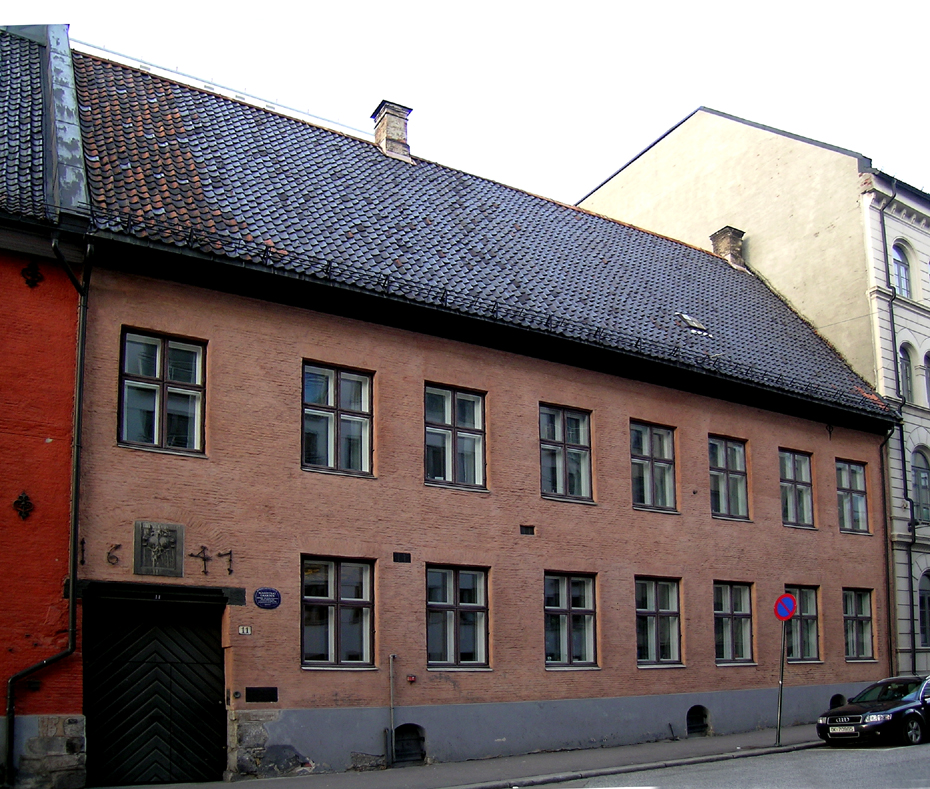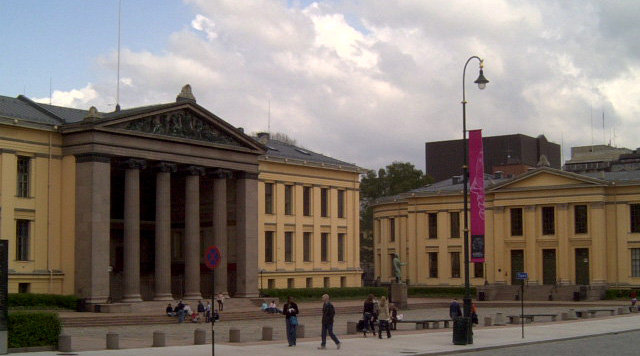|
Anton Wilhelm Brøgger (archaeologist)
Anton Wilhelm Brøgger (11 October 1884 – 29 August 1951) was a Norwegian archaeologist and politician. Personal life He was born in Stockholm as a son of professor of geology Waldemar Christofer Brøgger (1851–1940) and Antonie Scheel Siewers (1854–1933). He was a grandson of the book printer Anton Wilhelm Brøgger. In September 1909 he married Inger Ursin (1882–1941). He had the sons Waldemar Christofer Brøgger (1911–1991) and Niels Christian Brøgger (1914–1966), and through the former, the grandson Jan Brøgger. Career Brøgger finished his secondary education in 1903, but his higher education was sporadic. Without a formal examination, he wrote the paper ''Øxer av Nøstvettypen'', which was published in 1905 by the Norwegian Geological Survey. He participated in the archaeological investigations of Svarthola outside Stavanger, and wrote a report on the first paleolithic kitchen midden found in Norway, published in the ''Annals'' of Stavanger Museum ... [...More Info...] [...Related Items...] OR: [Wikipedia] [Google] [Baidu] |
Society For The Preservation Of Ancient Norwegian Monuments
Society for the Preservation of Ancient Norwegian Monuments () is an organization focused on conservation preservation in Norway. The Society was founded in 1844. The founders were painters, historians, art historians and archeologists, including J. C. Dahl and Joachim Frich. Nicolay Nicolaysen became chairman in 1851 and from 1860 was the association antiquarian. The purpose of the association is to protect and preserve buildings, churches and other forms of cultural heritage. It owns forty structures directly, including the stave churches at Borgund stave church, Borgund, Urnes stave church, Urnes, Hopperstad stave church, Hopperstad and Uvdal stave church, Uvdal. The Society has 18 county branches and 37 local branches in the counties. The branch structure resembles the counties of Norway, county structure of Norway, except that Oslo and Akershus are together, Møre and Romsdal is split into Sunnmøre, Nordmøre and Romsdal, and the town of Røros (town), Røros is a division of ... [...More Info...] [...Related Items...] OR: [Wikipedia] [Google] [Baidu] |
Parliament Of Norway
The Storting ( ; ) is the supreme legislature of Norway, established in 1814 by the Constitution of Norway. It is located in Oslo. The unicameral parliament has 169 members and is elected every four years based on party-list proportional representation in nineteen multi-seat constituencies. A member of the Storting is known in Norwegian as a ''stortingsrepresentant'', literally "Storting representative". The assembly is led by a president and, since 2009, five vice presidents: the presidium. The members are allocated to twelve standing committees as well as four procedural committees. Three ombudsmen are directly subordinate to parliament: the Parliamentary Intelligence Oversight Committee and the Office of the Auditor General. Parliamentarianism was established in 1884, with the Storting operating a form of "qualified unicameralism", in which it divided its membership into two internal chambers making Norway a de facto bicameral parliament, the Lagting and the Odelsting ... [...More Info...] [...Related Items...] OR: [Wikipedia] [Google] [Baidu] |
Karl Wefring
Karl may refer to: People * Karl (given name), including a list of people and characters with the name * Karl der Große, commonly known in English as Charlemagne * Karl of Austria, last Austrian Emperor * Karl (footballer) (born 1993), Karl Cachoeira Della Vedova Júnior, Brazilian footballer * Karl (surname) In myth * Karl (mythology), in Norse mythology, a son of Rig and considered the progenitor of peasants (churl) * ''Karl'', giant in Icelandic myth, associated with Drangey island Vehicles * Opel Karl, a car * ST ''Karl'', Swedish tugboat requisitioned during the Second World War as ST ''Empire Henchman'' Other uses * Karl, Germany, municipality in Rhineland-Palatinate, Germany * ''Karl-Gerät'', AKA Mörser Karl, 600mm German mortar used in the Second World War * KARL project, an open source knowledge management system * Korean Amateur Radio League, a national non-profit organization for amateur radio enthusiasts in South Korea * KARL, a radio station in Minnesota * Li ... [...More Info...] [...Related Items...] OR: [Wikipedia] [Google] [Baidu] |
Liberal Left Party
The Free-minded Liberal Party () was a political party in Norway founded in 1909 by the conservative-liberal faction of the Liberal Party. The party cooperated closely with the Conservative Party and participated in several short-lived governments, including two headed by Free-minded Prime Ministers. In the 1930s the party changed its name to the Free-minded People's Party () and initiated cooperation with nationalist groups. The party contested its last election in 1936, and was not reorganised in 1945. History The Free-minded Liberal Party was founded in March 1909 under influence of Norway's first independent Prime Minister, Christian Michelsen of the Liberal Party, after around a third of the Liberal parliamentary representatives had been excluded from a reconstitution of the Liberal Party in 1908. The party was founded in protest against the increasingly radical course of the "consolidated" Liberal Party, which the party's right wing considered to conflict with the party' ... [...More Info...] [...Related Items...] OR: [Wikipedia] [Google] [Baidu] |
List Of Rectors For The University Of Oslo
The rector of the University of Oslo is the university's highest officer, who serves as both its chief executive, its ceremonial head and as chairperson of the university board. The rector is directly elected among the (full) professors by all the members of the university community, that is academic employees, students and technical-administrative staff, who received the right to vote in this order. Until 1989, only professors were eligible to stand for election, although so far all rectors have been professors at the university. The rector's deputy and the university's second highest official, the pro-rector, is also directly elected at the same time. Both the rector and the pro-rector are elected for four-year terms and may stand for reelection to the same office once. The rectorate may also include one or more appointed vice-rectors, who rank below both the rector and the pro-rector. The rectorate forms the university's senior leadership and has the overall responsibility for ... [...More Info...] [...Related Items...] OR: [Wikipedia] [Google] [Baidu] |
Frostating
Frostating () was one of the four ancient popular assemblies or things () of medieval Norway. Historically, it was the site of court and assembly for Trøndelag, Nordmøre, and Hålogaland. The assembly had its seat at Tinghaugen in what is now Frosta Municipality. It functioned as a judicial and legislative body, resolving disputes and establishing laws. Frostating and Norway's three other ancient regional assemblies, the Borgarting, Eidsivating, and Gulating, were joined into a single jurisdiction during the late 13th century, when King Magnus the Lawmender had the existing body of law put into writing. Tinghaugen Tinghaugen, from the Old Norse words meaning 'assembly' and meaning 'hill', is close to the medieval church at Logtun. The site is represented by the Frostatinget bautasten at Tinghaugen. Frostating was arguably Norway's oldest court, pre-dating the Viking Age. The Frostating had authority over the eight districts in Trøndelag including (Nordmøre and ... [...More Info...] [...Related Items...] OR: [Wikipedia] [Google] [Baidu] |
Gulating
Gulating () was one of the four ancient popular assemblies or things (') of medieval Norway. Historically, it was the site of court and assembly for most of Western Norway, and assembled at Gulen. It functioned as a judicial and legislative body, resolving disputes and establishing laws. Gulating, along with Norway's three other ancient regional assemblies, the Borgarting, Eidsivating, and Frostating, were joined into a single jurisdiction during the late 13th century, when King Magnus the Lawmender had the existing body of law put into writing. History The Gulating was an annual parliamentary assembly which took place in Gulen, on the west coast of Norway north of Bergen, from approximately 900 to 1300 CE and was one of the oldest and largest parliamentary assemblies in medieval Norway. The assembly site was established early in the 10th century and the original legislative area covered the regions of Hordaland and Sogn og Fjordane. The Gulatinget Millennium Site is a ... [...More Info...] [...Related Items...] OR: [Wikipedia] [Google] [Baidu] |
Biographical Dictionary
A biographical dictionary is a type of encyclopedic dictionary limited to biographical information. Many attempt to cover the major personalities of a country (with limitations, such as living persons only, in ''Who's Who'', or deceased people only, in the ''Dictionary of National Biography''). Others are specialized, in that they cover important names in a subject field, such as architecture or engineering. History in the Islamic civilization Tarif Khalidi stated that the genre of biographical dictionaries is a "unique product of Arab Muslim culture". The earliest extant example of the biographical dictionary dates from 9th-century Iraq, and by the 16th-century it was a firmly established and well-respected form of historical writing. They contain more social data for a large segment of the population than that found in any other pre-industrial society. The earliest biographical dictionaries initially focused on the lives of the prophets of Islam and Sahaba, their companions, ... [...More Info...] [...Related Items...] OR: [Wikipedia] [Google] [Baidu] |
Viking Ship Museum (Oslo)
The Viking Ship Museum () is located on the Bygdøy peninsula in Oslo, Norway. It is temporarily closed from September 2021 until 2027. It is part of the Museum of Cultural History of the University of Oslo, and houses three Viking era burial ships that were found as part of archaeological finds from Tune, Gokstad (Sandefjord), Oseberg (Tønsberg) and the Borre mound cemetery. Attractions The museum is most famous for the completely whole Oseberg ship, excavated from the largest known ship burial in the world. Other main attractions at the Viking Ship Museum are the Gokstad ship and Tune ship. Additionally, the Viking Age display includes sledges, beds, a horse cart, wood carving, tent components, buckets and other grave goods. History In 1913, Swedish professor Gabriel Gustafson proposed a specific building to house Viking Age finds that were discovered at the end of the 19th and the beginning of the 20th century. The Gokstad and Oseberg ships had been stored in tempora ... [...More Info...] [...Related Items...] OR: [Wikipedia] [Google] [Baidu] |
Institute For Comparative Research In Human Culture
An institute is an organizational body created for a certain purpose. They are often research organisations (research institutes) created to do research on specific topics, or can also be a professional body. In some countries, institutes can be part of a university or other institutions of higher education, either as a group of departments or an autonomous educational institution without a traditional university status such as a "university institute", or institute of technology. In some countries, such as South Korea and India, private schools are sometimes referred to as institutes; also, in Spain, secondary schools are referred to as institutes. Historically, in some countries, institutes were educational units imparting vocational training and often incorporating libraries, also known as mechanics' institutes. The word "institute" comes from the Latin word ''institutum'' ("facility" or "habit"), in turn derived from ''instituere'' ("build", "create", "raise" or "educat ... [...More Info...] [...Related Items...] OR: [Wikipedia] [Google] [Baidu] |
University Of Oslo
The University of Oslo (; ) is a public university, public research university located in Oslo, Norway. It is the List of oldest universities in continuous operation#Europe, oldest university in Norway. Originally named the Royal Frederick University, the university was established in 1811 as the de facto Norwegian continuation of Denmark-Norway's common university, the University of Copenhagen, with which it shares many traditions. It was named for King Frederick VI of Denmark and Norway, and received its current name in 1939. The university was commonly nicknamed "The Royal Frederick's" (''Det Kgl. Frederiks'') before the name change, and informally also referred to simply as ''Universitetet'' (). The university was the only university in Norway until the University of Bergen was founded in 1946. It has approximately 27,700 students and employs around 6,000 people. Its faculties include (Lutheranism, Lutheran) theology (with the Lutheran Church of Norway having been Norway's ... [...More Info...] [...Related Items...] OR: [Wikipedia] [Google] [Baidu] |





